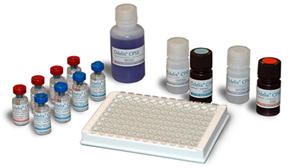Odelis CPSE
ELISA kit for the measurement of CPSE
| Presentation | Advantages | |
|---|---|---|
|
Method: ELISA type immunoassay on microwell Analysis: CPSE assay (Canine Prostate-Specific arginine Esterase) on canine serum or plasma Sample: plasma, serum Handling time: 2 hours Reading: 10 minutes Presentation: Box set containing 1 microplate of 96 wells + reagents Storage: 18 months at 2°C – 8°C Performances: For the diagnosis of Benign Prostatic Hyperplasia |
|
| Why use Odelis CPSE ? |
|---|
|
Benign Prostatic Hyperplasia in the dog: a common disease with serious consequences With age, and under the effect of impregnation with male hormones, the prostate of dogs is prone to the development of spontaneous diseases. The most commonly encountered disease is Benign Prostatic Hyperplasia or BPH, which corresponds to an increase in the number and size of the cells of the organ. Some dogs may present early histological lesions from as young as 5 years of age. (2) The increase in the size of the prostate is progressive and continuous. An excessively large prostate can cause compression of the surrounding pelvic organs and the onset of painful and uncomfortable symptoms for the animal: constipation, tenesmus, dysuria, haematuria, lameness (compression of the intra-pelvic nerve roots)… (3) Benign prostatic hyperplasia in the dog can predispose the animal to more serious diseases such as prostatitis, the appearance of voluminous prostatic cysts, or prostatic abscesses. (4) CPSE (Canine Prostate-Specific arginine Esterase), a specific marker for BPH CPSE is a hormone that is secreted by the prostate cells, under the control of androgens. This protein is a normal component of sperm (representing more than 90% of the proteins in the prostatic fluid). Hyperplasia of the prostatic cells induces an increase in the serum concentration of CPSE(5). |
| When use Odelis CPSE ? |
|---|
|
Odelis CPSE provides the practitioner with a rapid means of evaluating the blood CPSE concentration in the dog, and helps them to confirm or eliminate a diagnosis of prostatic hyperplasia so that they can rapidly instigate appropriate treatment. In dogs over 5 years of age, a CPSE assay provides an early and simple means of detecting Benign Prostatic Hyperplasia, from the earliest stages. Odelis CPSE is a simple and reliable alternative to rectal examination, which is often poorly tolerated by the animal and their owner. Odelis CPSE enables the practitioner to justify the performance of additional examinations to eliminate the possibility of concurrent disease (cysts, abscess, prostatitis, etc.) |
Instruction for use Odelis CPSE
Bibliography:
(1) Lévy X., Mimouni P., Fontbonne A., Derre G., Claret E.,Audhuy S., Morlet J.Performance evaluation of the new blood test Odelis CPSETM in the diagnosis of Benign Prostatic Hyperplasia (BPH) in dogs. In. Prodeeding of the 6th EVSSAR Annual Symposium, Wroclaw 2009 - Poland
(2) Barsanti J. Canine prostatic disease. in Proceedings of the International SCIVAC Congress, Rimini 2008- Italy
(3) Vesrtegen J. Managment of prostatic disorders . In : Proceedings of the International WSAVA Congress, Granada 2002- Spain
(4) Johnston SD, Kustritz MVR, Olson PNS. Benign prostatic hypertrophy/hyperplasia. In : Canine and feline theriogenology. WB Saunders, Philadelphia. 2001 : 340-341
(5) Bell FW, Klausner JS, Hayden DW et coll. Evaluation of serum and seminal plasma markers in the diagnosis of canine prostatic disorders. J Vet Intern Med. 1995 ; 9 ; 149-153


